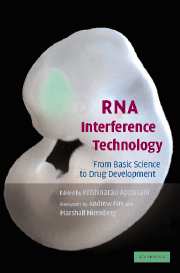Book contents
- Frontmatter
- Contents
- Foreword by Andrew Fire
- Foreword by Marshall Nirenberg
- List of Contributors
- Introduction
- Section one Basic RNAi, siRNA, microRNAs and gene-silencing mechanisms
- 1 RNAi beginnings, Overview of the pathway in C. elegans
- 2 Dicer in RNAi: Its roles in vivo and utility in vitro
- 3 Genes required for RNA interference
- 4 MicroRNAs: A small contribution from worms
- 5 miRNAs in the brain and the application of RNAi to neurons
- Section two Design, synthesis of siRNAs
- Section three Vector development and in vivo, in vitro and in ovo delivery methods
- Section four Gene silencing in model organisms
- Section five Drug target validation
- Section six Therapeutic and drug development
- Section seven High-throughput genome-wide RNAi analysis
- Index
- Plate section
- References
1 - RNAi beginnings, Overview of the pathway in C. elegans
Published online by Cambridge University Press: 31 July 2009
- Frontmatter
- Contents
- Foreword by Andrew Fire
- Foreword by Marshall Nirenberg
- List of Contributors
- Introduction
- Section one Basic RNAi, siRNA, microRNAs and gene-silencing mechanisms
- 1 RNAi beginnings, Overview of the pathway in C. elegans
- 2 Dicer in RNAi: Its roles in vivo and utility in vitro
- 3 Genes required for RNA interference
- 4 MicroRNAs: A small contribution from worms
- 5 miRNAs in the brain and the application of RNAi to neurons
- Section two Design, synthesis of siRNAs
- Section three Vector development and in vivo, in vitro and in ovo delivery methods
- Section four Gene silencing in model organisms
- Section five Drug target validation
- Section six Therapeutic and drug development
- Section seven High-throughput genome-wide RNAi analysis
- Index
- Plate section
- References
Summary
Introduction
The term “RNA interference” (RNAi) was coined by Andy Fire and Craig Mello to describe a sequence-specific gene silencing phenomenon of remarkable potency. They originally identified the main features of RNAi in C. elegans: initiation by double-stranded RNA (dsRNA) and ability to spread systemically (Fire et al., 1998). RNAi is recognized now as an ancient mechanism utilized by metazoans for silencing of foreign genetic elements and for the precise regulation of endogenous genes during development.
Initial studies of RNAi in C. elegans indicated that silencing was transient, did not affect the sequence of genomic DNA, and likely targeted mature mRNA (Fire et al., 1998; Montgomery et al., 1998). These observations identified RNAi as a sequence specific post-transcriptional gene silencing (PTGS) mechanism similar to those described in plants and fungi (Montgomery and Fire, 1998). The discovery of 21–25 nt long short interfering RNAs (siRNAs) as common intermediates in PTGS (Hamilton and Baulcombe, 1999) and RNAi (Zamore et al., 2000; Parrish et al., 2000; Tijsterman et al., 2002) further confirmed shared mechanistic features of sequence-specific silencing processes.
Steps of RNAi pathway in C. elegans
The remarkable response to introduction of just a few molecules of dsRNA per cell in C. elegans (Fire et al., 1998) suggested the existence of a pathway of genes responsible for the silencing process at the level of the whole organism. Screens for RNAi deficient (rde) mutants in the Mello lab (Tabara et al., 1999) identified two categories of mutants.
Information
- Type
- Chapter
- Information
- RNA Interference TechnologyFrom Basic Science to Drug Development, pp. 17 - 28Publisher: Cambridge University PressPrint publication year: 2005
